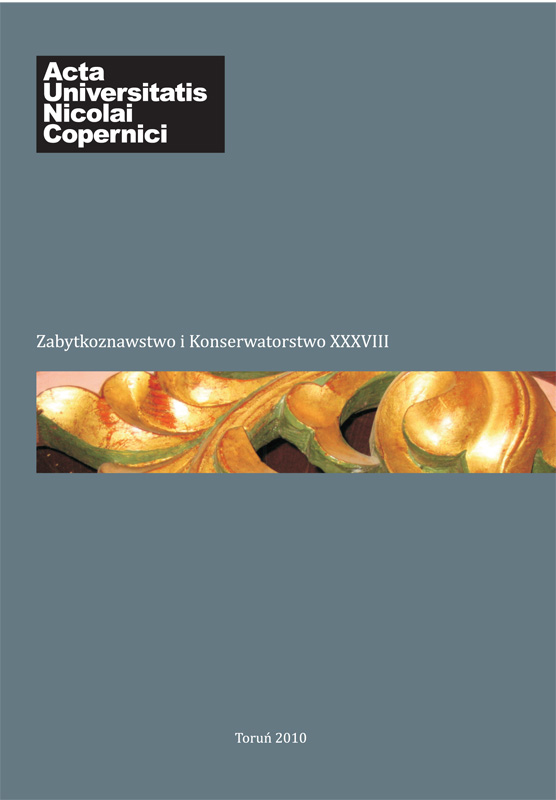Wprowadzenie
DOI:
https://doi.org/10.12775/2046Abstrakt
We hand over to the Readers interested in the issues of art the next number of AUNC “Conservation and Restoration Studies.” In a changed form, with papers both on the history of art and the technology and conservation of monuments. This is a conscious decision, aiming to make this volume more attractive and more diversifi ed. The volume contains articles relating with the history of art, touching upon important research issues, devoted to techniques and technology of artworks as well as studies on conservation problems, often related to the state of preservation and conservation treatment. The paper by Alicja Saar-Kozłowska The problem of attribution of architectural and sculpted furnishing of the Kołudzki family chapel in Gniezno cathedral is an attempt of recognising the features of sculptor’s workshop employed for execution of architectural and sculpted furnishing of the Kołudzki family chapel in Gniezno cathedral. The author in her study made use of the possibilities given by digital photography – abundant, precise, rich in details, documenting the previous condition of the monument and made during conservation treatment. The article by Dariusz Markowski and Sebastian Smagłowski is devoted to The mysterious history of the collection of heraldic shields of the Order of St. John in Słońsk and their conservation problems. The authors presented the history and characterised technique of the making of selected, representative heraldic shields of the knights of the Order of St. John of the Bailiwick of Brandenburg. Apart from the state of condition they have presented the detailed course of conservation and restoration process, pointing out to the necessity of executing the reconstruction of missing parts of supports and paint layers. Justyna Olszewska-Świetlik in her article The issues of painters’ workshop of the Hans Gronau epitaph painting from Our Lady’s Basilica in Gdańsk presented technical structure of the epitaph painting executed in a Gdańsk painter’s atelier in 1612. Basing on the integrated physical, chemical and instrumental research artists’ materials applied have been identifi ed and the most characteristic features of painters’ workshop, that executed the painting have been characterised. According to the author the technique and technology of the making are rooted in the tradition of 17th century painting. Illusionistic theatre stage setting as a branch of decorative painting. Technique of the making on example of decorations of French court theatres is a paper submitted by Elżbieta Szmit-Naud discussing the material aspects of execution of a particular type of decorative painting, that are illusionistic theatre stage settings. The author in a brief outline presented the history of illusionistic repertoire decorations, the kinds of elements they consisted of as well as technical requirements they had to meet, and fi nally she has characterised the materials, their application and the tools used. Particular attention has been paid to the principles and subsequent stages of execution of painted stage decorations in 18th and 19th centuries. Elżbieta Basiul in her paper Conservation research of mural paintings in the parish church of St. Simon and St. Jude Thaddeus in Kosieczyn presented the results of conservation research determining the presence of polychrome and further deposits on the inner walls of the parish church in Kosieczyn. The detailed research proved the presence of the oldest painted decoration executed directly on the wooden support. The author carried out a detailed identifi cation of materials making the subsequent chronological strata, that allowed for re-creation of the chronology of making the decoration. Teresa Łękawa-Wysłouch in her article Research on the materials used for reintegration of the injuries of priming in paintings on canvas presented the description and results analysis of materials used or potentially suitable for reintegration of the injuries of priming in paintings on canvas. The author has submitted to detailed analysis, including aging tests, fi ve ready-made brand products and compared them with two products made by the recipes. Combining such an interesting, and in the same time diverse material, this volume demonstrates also what is the most valuable in the tradition of the Institute for the Study, Conservation and Restoration of Cultural Heritage – the work, often collaborative and complementary of both theoreticians and practicians. One should hope, that it is not an isolated case, and that the next numbers shall continue that new formula. We are also pleased with a new graphic design. The assumption was, that the cover of this new volume could be associated with its contents, that is the papers on arts. That – as the art itself, that is colourful – it encouraged both the reading and the visual perception.
Pobrania
Opublikowane
Jak cytować
Numer
Dział
Licencja
CC BY-ND 4.0. Posiadaczem prawa autorskiego (Licencjodawcą) jest Autor, który na mocy umowy licencyjnej udziela nieodpłatnie prawa do eksploatacji dzieła na polach wskazanych w umowie.
- Licencjodawca udziela Licencjobiorcy licencji niewyłącznej na korzystanie z Utworu/przedmiotu prawa pokrewnego w następujących polach eksploatacji: a) utrwalanie Utworu/przedmiotu prawa pokrewnego; b) reprodukowanie (zwielokrotnienie) Utworu/przedmiotu prawa pokrewnego drukiem i techniką cyfrową (e-book, audiobook); c) wprowadzania do obrotu egzemplarzy zwielokrotnionego Utworu/przedmiotu prawa pokrewnego; d) wprowadzenie Utworu/przedmiotu prawa pokrewnego do pamięci komputera; e) rozpowszechnianie utworu w wersji elektronicznej w formule open access na licencji Creative Commons (CC BY-ND 4.0) poprzez platformę cyfrową Wydawnictwa Naukowego UMK oraz repozytorium UMK.
- Korzystanie przez Licencjobiorcę z utrwalonego Utworu ww. polach nie jest ograniczone czasowo ilościowo i terytorialnie.
- Licencjodawca udziela Licencjobiorcy licencji do Utworu/przedmiotu prawa pokrewnego nieodpłatnie na czas nieokreślony
PEŁEN TEKST UMOWY LICENCYJNEJ >>
Statystyki
Liczba wyświetleń i pobrań: 284
Liczba cytowań: 0



